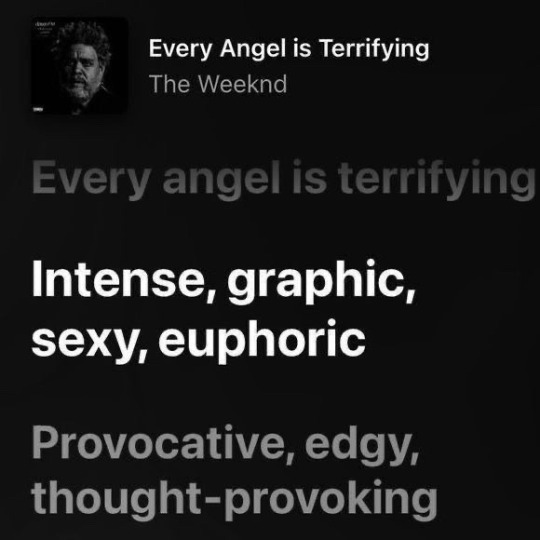Don't wanna be here? Send us removal request.
Text









⛤ : / ›› like or reblog if you save/use. and if you want, credit bawkugos ♡
331 notes
·
View notes
Text






❝ 𝗅𝗂𝗄𝖾 𝖺 𝖿𝗈𝗋𝖼𝖾 𝗍𝗈 𝖻𝖾 𝗋𝖾𝖼𝗄𝗈𝗇𝖾𝖽 𝗐𝗂𝗍𝗁, 𝖺 𝗆𝗂𝗀𝗁𝗍𝗒 𝗈𝖼𝖾𝖺𝗇 𝗈𝗋 𝖺 𝗀𝖾𝗇𝗍𝗅𝖾 𝗄𝗂𝗌𝗌. 𝗂 𝗐𝗂𝗅𝗅 𝐥𝐨𝐯𝐞 𝐲𝐨𝐮 𝗐𝗂𝗍𝗁 𝖾𝗏𝖾𝗋𝗒 𝗌𝗂𝗇𝗀𝗅𝖾 𝗍𝗁𝗂𝗇𝗀 𝗂 𝗁𝖺𝗏𝖾.


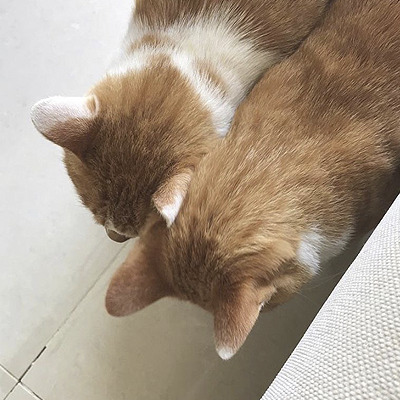


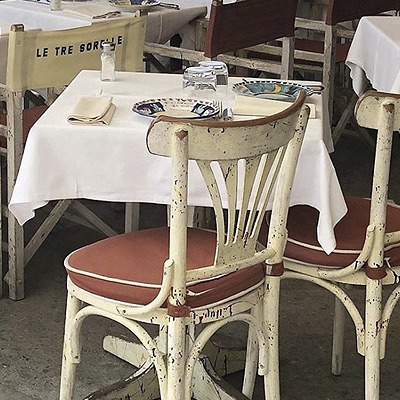
𝗅𝗂𝗄𝖾 𝖺 𝗍𝗂𝖽𝖺𝗅 𝗐𝖺𝗏𝖾, 𝗐𝖾'𝗅𝗅 𝗆𝖺𝗄𝖾 𝖺 𝗆𝖾𝗌𝗌 𝗈𝗋 𝖼𝖺𝗅𝗆 𝗐𝖺𝗍𝖾𝗋𝗌, 𝗂𝖿 𝗍𝗁𝖺𝗍 𝗌𝖾𝗋𝗏𝖾𝗌 𝗒𝗈𝗎 𝖻𝖾𝗌𝗍. 𝗂 𝗐𝗂𝗅𝗅 𝐥𝐨𝐯𝐞 𝐲𝐨𝐮 𝗐𝗂𝗍𝗁𝗈𝗎𝗍 𝖺𝗇𝗒 𝗌𝗍𝗋𝗂𝗇𝗀𝗌 𝖺𝗍𝗍𝖺𝖼𝗁𝖾𝖽. ❞
224 notes
·
View notes
Text









⛤ : / ›› like or reblog if you save/use. and if you want, credit bawkugos ♡
331 notes
·
View notes
Text

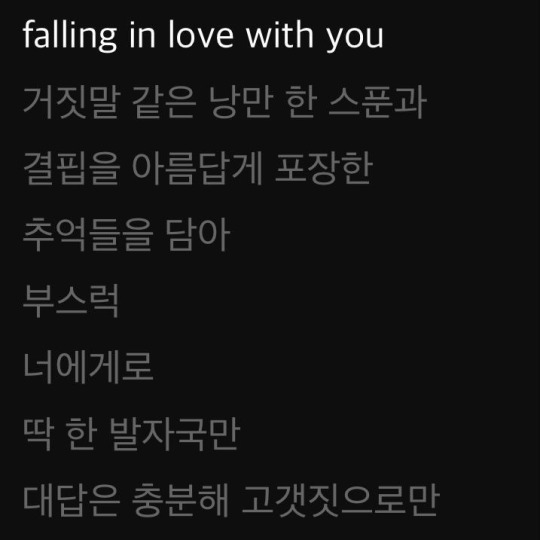
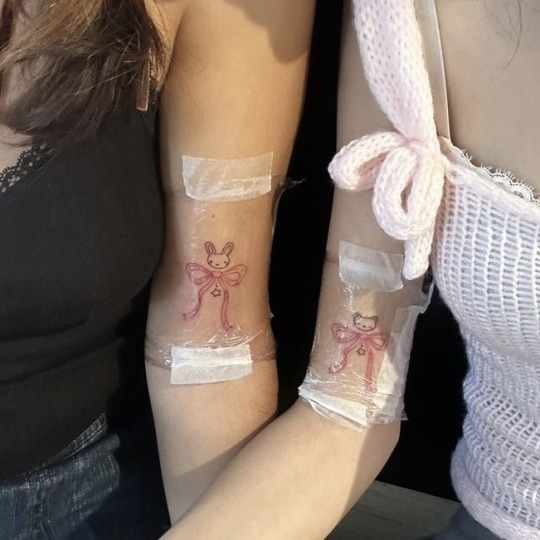
nothing in the world belongs to me but



my love, mine, all mine, all mine.



like or reblog if you use or save - don’t repost
541 notes
·
View notes
Text
Assassination Methods Through the Decades: A Writer’s Handbook
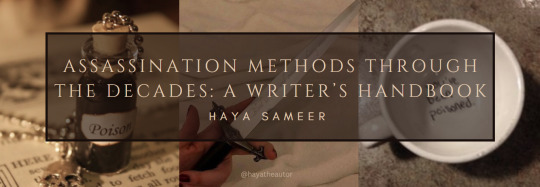
When it comes to writing about assassination, historical accuracy and understanding the evolution of methods can significantly enhance the authenticity and impact of your narrative. This guide is designed to help writers explore the diverse and often brutal methods of assassination that have been used throughout the centuries. From the poisonings of ancient times to the covert killings of medieval assassins, here’s a comprehensive guide bound to give you the perfect inspiration for your assassination scenes.
Ancient and Medieval Assassination Methods
Poisoning
Poisoning is one of the oldest methods of assassination, dating back to ancient civilizations such as Greece, Rome, and Egypt. The allure of poison lies in its ability to kill without physical confrontation, often leaving little trace of the perpetrator.
Common Poisons:
Hemlock: Famously used in the execution of Socrates, hemlock was a slow-acting poison that caused paralysis, leading to death by respiratory failure.
Arsenic: Known as the "inheritance powder," arsenic was a favorite among those seeking to kill discreetly. Its symptoms could be mistaken for natural illness, making it a popular choice in political and familial power struggles.
Belladonna: Also known as deadly nightshade, belladonna was used in both small and large doses to incapacitate or kill. The poison caused hallucinations, dilated pupils, and eventually death.
Historical Examples:
Socrates (399 BC): The Greek philosopher was sentenced to death by drinking a concoction containing hemlock, a method chosen for its relative humanity compared to other executions.
Emperor Claudius (54 AD): It is widely believed that the Roman Emperor Claudius was poisoned by his wife, Agrippina, using a dish of poisoned mushrooms to secure her son Nero's place on the throne.
Administration Methods:
Poisons were often mixed into food or drink, applied to the skin via ointments, or even introduced into the body through small, concealed needles. Assassins needed to be knowledgeable in the art of dosage to ensure a successful kill without immediate detection.
Symptoms:
Victims of poisoning would often suffer a range of symptoms depending on the poison used. These could include severe abdominal pain, vomiting, diarrhea, convulsions, and eventually, death. The slow progression of symptoms allowed the assassin time to escape, and in many cases, the cause of death was not immediately apparent, lending an air of mystery to the assassination.
Bladed Weapons
Before the advent of firearms, blades were the primary tools of assassins. Daggers, swords, and other sharp instruments were favored for their portability and effectiveness in close combat situations.
Types of Blades:
Daggers: Small, easily concealed, and lethal at close range, daggers were the weapon of choice for many assassins. The Roman pugio and the medieval stiletto were particularly popular.
Swords: Larger and more visible, swords were often used in assassinations where the element of surprise was not necessary, such as in the heat of battle or a public execution.
Kris: A wavy-edged dagger used in Southeast Asia, the kris was known for its spiritual significance as well as its lethality.
Famous Assassinations:
Julius Caesar (44 BC): Perhaps the most famous assassination in history, Caesar was stabbed 23 times by a group of Roman senators led by Brutus and Cassius. The attack was swift and brutal, demonstrating the effectiveness of a well-coordinated knife attack.
King Duncan (11th century): The assassination of King Duncan by Macbeth (as famously dramatized by Shakespeare) is an example of a stealthy, intimate kill using a blade, where the act was both personal and symbolic.
Techniques:
Assassins using bladed weapons often relied on stealth, speed, and precision. A well-placed stab to the heart, throat, or kidneys could kill instantly or within moments, leaving the assassin time to escape. In some cultures, assassins were trained in martial arts that emphasized quick, lethal strikes.
Weapon Concealment:
Blades were often concealed in clothing, boots, or even within the folds of long hair or turbans. The art of hiding a weapon until the crucial moment was key to the success of many assassinations.
Strangulation and Garroting
Strangulation was another favored method of assassination in ancient and medieval times, especially for those who sought to avoid bloodshed or noise. The garrote, a weapon used to strangle a victim, was particularly effective in this regard.
Tools Used:
Garrote: A length of wire, cord, or fabric used to strangle a victim from behind. The garrote was silent, deadly, and could be easily concealed, making it a popular choice for assassins throughout history.
Hands: In cases where no weapon was available, assassins might rely on their own hands to strangle a victim. This method required physical strength and proximity but could be effective in the right circumstances.
Historical Examples:
Sicarii (1st century AD): A group of Jewish zealots who used short daggers to stab Roman collaborators in crowded places. The Sicarii were also known for strangling their enemies with garrotes.
Medieval Europe: Strangulation was sometimes used as a method of execution for nobles, where a public beheading or hanging might be considered dishonorable.
Execution:
The assassin would typically approach the victim from behind, loop the garrote around their neck, and tighten it quickly and forcefully, cutting off the victim's air supply. Death would occur within minutes due to asphyxiation or a broken neck.
Advantages and Risks:
The main advantage of strangulation was its silence. Unlike a stabbing or poisoning, strangulation could be done without alerting others nearby. However, it required physical strength and a certain level of risk, as the victim might struggle or fight back.
Renaissance and Early Modern Era
Firearms
The Renaissance and early modern era marked a significant turning point in the history of assassination methods with the introduction of firearms. Gunpowder, first developed in China, made its way to Europe and fundamentally changed the dynamics of warfare and personal combat, including assassination.
Introduction of Gunpowder and Early Firearms in Assassinations:
The development of gunpowder-based weapons provided assassins with a new tool that could kill from a distance, reducing the risk of capture. Early firearms such as matchlock and flintlock pistols were bulky and required significant skill to use effectively, but their lethality made them a preferred choice for assassins by the 16th century.
Firearms allowed for quick, deadly strikes that were difficult to defend against, making them ideal for assassinations where the element of surprise was crucial. The loud noise and smoke, however, meant that escape required careful planning.
How Accuracy and Concealability Impacted Methods:
Early firearms were not known for their accuracy, which necessitated close-range attacks. Assassins often had to be within a few feet of their target to ensure a successful hit. As a result, these weapons were usually concealed under cloaks or in specially designed holsters that allowed for a quick draw.
Over time, improvements in gun design, such as rifling and better gunpowder, increased accuracy and allowed for slightly longer-range assassinations. Despite these advancements, concealability remained a critical factor, as firearms were often large and unwieldy compared to daggers or poison.
Key Assassinations Involving Firearms:
Assassination of King Henry IV of France (1610): King Henry IV was assassinated by François Ravaillac, a Catholic fanatic who stabbed the king while his carriage was stopped in traffic. While this was a stabbing, the period saw a rise in the use of firearms for such purposes. Henry IV's era was marked by religious turmoil, where firearms began to play a role in political assassinations.
Assassination of William the Silent (1584): William I of Orange, also known as William the Silent, was assassinated by Balthasar Gérard using a handgun. This marked one of the first successful assassinations of a prominent figure using a firearm, demonstrating the growing popularity of this method during the Renaissance.
Poison Rings and Needles
The Renaissance period also saw the refinement of more discreet methods of assassination, particularly the use of poison rings and needles. These tools allowed for covert poisoning, often in social settings where other weapons might not be feasible.
Discreet Poisoning Techniques:
Poison Rings: These rings contained a small hidden compartment that could hold a lethal dose of poison. The wearer could discreetly slip poison into a drink or onto food with a simple flick of the ring’s lid. Poison rings were popular among nobility and were often used in court intrigues where open violence would have been impossible.
Poison Needles: These were small, sharp needles often coated with a fast-acting poison. They could be hidden in clothing or other objects and used to deliver a quick, often unnoticed prick that would introduce the poison into the victim’s bloodstream. Needles were ideal for use in crowded settings, such as royal courts or banquets, where the assassin could blend into the crowd after delivering the fatal dose.
Notable Instances of Usage:
Lucrezia Borgia (1480-1519): While the extent of her involvement in poisoning is debated, Lucrezia Borgia, a member of the infamous Borgia family, is often associated with the use of poison rings to eliminate her political enemies. The Borgia family’s reputation for cunning and ruthlessness made poison one of their favored tools for securing power.
Catherine de' Medici (1519-1589): The French queen consort and mother to several kings of France, Catherine de' Medici, was rumored to have employed poison rings and needles to remove rivals and control court politics during the Wars of Religion in France.
Explosives
The early use of explosives in assassination attempts represented a shift towards more destructive and indiscriminate methods of killing, often targeting not just the primary victim but also anyone nearby. Explosives became a favored tool in situations where a dramatic statement was intended, or where traditional methods of assassination were not feasible.
The Early Use of Explosives in Assassination Attempts:
Explosives were first used in assassination attempts during the Renaissance and early modern periods, although their use was limited by the difficulty of creating and handling reliable explosive devices. Gunpowder was the primary explosive material, and it required careful handling to avoid premature detonation.
The use of explosives was often tied to larger political or religious motivations, as the collateral damage caused by an explosion could have a significant psychological impact on the population or ruling class.
The Effectiveness and Risks Involved:
Explosives were highly effective in causing mass casualties and instilling fear, but they also carried significant risks for the assassin. Improper handling could result in accidental detonation, and the use of explosives often made it difficult for the assassin to escape unnoticed.
The unpredictability of early explosives also meant that they could fail to detonate or cause less damage than intended, leaving the assassin vulnerable to capture and execution.
Historical Example:
The Gunpowder Plot (1605): One of the most famous early uses of explosives in an assassination attempt was the Gunpowder Plot, in which a group of Catholic conspirators, including Guy Fawkes, attempted to blow up the House of Lords during the State Opening of Parliament, with the aim of killing King James I and much of the Protestant aristocracy. The plot was foiled, but it demonstrated the potential of explosives as a tool for political assassination.
The Industrial Revolution and Early 20th Century
Sniper Rifles
The Industrial Revolution brought about significant advancements in weaponry, including the development of sniper rifles. These long-range firearms allowed assassins to strike from a distance, often without being seen or heard.
The Rise of Long-Range Assassinations:
Sniper rifles were designed for accuracy over long distances, enabling assassins to kill targets from hundreds of meters away. This development allowed for greater safety and discretion, as the assassin could remain hidden while observing the target through a scope.
The advent of rifling, which gave bullets a stable, spinning motion, greatly improved accuracy and range. Coupled with telescopic sights, these rifles became the preferred tool for military and political assassinations during the late 19th and early 20th centuries.
Famous Cases:
Assassination of Archduke Franz Ferdinand (1914): Although Archduke Franz Ferdinand was ultimately killed by a handgun, the era in which he was assassinated saw the rise of snipers as a significant threat. The tensions and technologies of the time set the stage for future political assassinations using sniper rifles.
Assassination of President John F. Kennedy (1963): Although beyond the early 20th century, the assassination of JFK by a sniper is a prominent example of how sniper rifles became synonymous with political killings. This event marked a turning point in the history of assassination, highlighting the lethal effectiveness of long-range firearms.
Car Bombs
The introduction and evolution of vehicular explosives, particularly car bombs, added a new dimension to assassination tactics in the 20th century. Car bombs became a favored method due to their potential for mass destruction and the ability to target individuals in transit.
Introduction and Evolution of Vehicular Explosives:
The use of car bombs began in earnest during the early 20th century, particularly in conflicts where traditional methods of assassination were either too risky or ineffective. These bombs could be planted in vehicles and detonated remotely, offering a high degree of control over the timing and impact of the explosion.
Over time, car bombs became more sophisticated, with the addition of remote triggers, time delays, and increased explosive power. They were used not only in targeted assassinations but also in acts of terrorism aimed at destabilizing governments or instilling fear in the populace.
Techniques for Planting and Detonating:
Planting a car bomb required detailed planning, as the vehicle needed to be accessed and rigged with explosives without arousing suspicion. Detonation methods varied from simple timed fuses to complex remote-controlled devices, allowing the assassin to maintain distance from the blast.
The challenge for assassins was ensuring the target was inside or near the vehicle at the moment of detonation. This often involved careful observation of the target’s routines and the use of decoys or distractions to ensure the bomb’s effectiveness.
Chemical and Biological Agents
The 20th century saw the development and use of more advanced chemical and biological agents in assassinations. These methods, often invisible and insidious, allowed for killings that were difficult to trace and could be disguised as natural causes.
Use of More Advanced Poisons and Toxins:
With advancements in chemistry and biology, assassins gained access to a range of deadly substances that could kill quickly or slowly, depending on the agent used. Toxins like ricin, cyanide, and various nerve agents became tools of state-sponsored assassinations, particularly during the Cold War.
Chemical agents could be introduced through food, drink, or even via contact with the skin or inhalation, making them versatile and deadly. Biological agents, on the other hand, could cause diseases that mimicked natural illnesses, allowing assassins to kill without immediate suspicion.
Historical Examples:
Ricin: Ricin, a highly potent toxin derived from castor beans, was famously used in the assassination of Bulgarian dissident Georgi Markov in 1978. Markov was attacked with a modified umbrella that injected a tiny pellet containing ricin into his leg, leading to his death a few days later.
Cyanide: Cyanide has been used in various assassinations due to its rapid action and high lethality. One of the most notorious uses of cyanide was in the mass suicide-murder in Jonestown in 1978, where members of the Peoples Temple ingested cyanide-laced punch, although this was not an assassination in the traditional sense, it demonstrated the deadly effectiveness of the poison.
These innovations in assassination methods during the Industrial Revolution and early 20th century reflected the growing complexity of warfare and espionage, as well as the increasing role of technology in shaping the tactics of assassins.
Modern and Contemporary Assassination Methods
Silenced Firearms
In the modern era, the evolution of silenced firearms, or firearms equipped with suppressors, has played a significant role in covert assassinations. The suppressor, commonly known as a silencer, reduces the noise and muzzle flash of a firearm, allowing assassins to operate with a higher degree of stealth.
The Evolution of Suppressors and Their Use in Covert Assassinations:
Suppressors were first developed in the early 20th century and have since become a staple in the arsenal of assassins. Initially, suppressors were bulky and limited to specific firearms, but advancements in technology have made them more compact, effective, and adaptable to a wide range of weapons.
Silenced firearms are ideal for close-quarters assassinations where discretion is paramount. The reduced noise levels prevent immediate detection, giving the assassin time to escape or even carry out multiple hits without alerting nearby individuals.
High-Profile Cases:
Cold War Assassinations: During the Cold War, silenced firearms were frequently used by intelligence agencies on both sides of the Iron Curtain. The KGB, CIA, and MI6, among others, employed suppressors in various covert operations to eliminate targets without drawing attention.
Georgi Markov (1978): Although Markov’s assassination in London involved a poison-tipped umbrella, the use of suppressors was prevalent in the same period for similar covert operations. This era exemplified the silent, precise methods preferred by state-sponsored assassins.
Remote-Controlled Devices
The rise of remote-controlled devices, including drones and other modern technologies, has introduced a new dimension to assassination methods. These devices allow assassins to strike from a distance, often from thousands of miles away, with precision and minimal risk.
Drones and Other Modern Technologies in Assassination:
Drones, equipped with cameras and weapons, have revolutionized modern warfare and assassination. These unmanned aerial vehicles can be operated remotely, providing real-time surveillance and the ability to deliver lethal force with pinpoint accuracy. Drones are particularly effective in targeting individuals in difficult-to-reach or heavily guarded locations.
Other remote-controlled devices, such as bombs or cars rigged to detonate via remote, offer similar advantages. These methods allow the assassin to maintain a safe distance from the target, reducing the likelihood of capture or identification.
Notable Instances in Recent History:
Qasem Soleimani (2020): One of the most high-profile drone assassinations in recent history was the killing of Iranian General Qasem Soleimani by a U.S. drone strike in Baghdad. This event highlighted the capabilities of drone technology in executing precise, targeted killings with global political implications.
The Killing of Anwar al-Awlaki (2011): The American-born cleric and al-Qaeda leader was targeted and killed by a drone strike in Yemen, marking a significant moment in the use of remote-controlled devices in the War on Terror.
Cyber-Assassination
As technology continues to advance, the concept of cyber-assassination has emerged as a new frontier in covert operations. This method involves using cyber means to assassinate individuals, such as hacking into medical devices or other critical systems.
The Concept of Assassination Through Cyber Means:
Cyber-assassination leverages the vulnerabilities in modern technology, particularly medical devices like pacemakers or insulin pumps, which can be hacked to deliver a fatal outcome. This method represents a shift from physical to digital assassination, where the target can be killed without the assassin ever being in the same country, let alone the same room.
Cyber-attacks can also target critical infrastructure, leading to deaths through indirect means such as causing traffic accidents by hacking self-driving cars or disrupting life support systems in hospitals.
Ethical and Legal Implications:
The rise of cyber-assassination raises significant ethical and legal questions. Unlike traditional assassination methods, which can be physically traced, cyber-attacks are often difficult to attribute, making accountability a major issue. This anonymity can lead to increased use of such methods by state and non-state actors alike.
Legal frameworks have yet to fully catch up with the technological realities of cyber-assassination. As a result, there is a grey area regarding the legality of such actions, particularly in the context of international law and the rules of engagement in warfare.
Assassination Methods by Region
Europe
Throughout history, Europe has seen a variety of assassination methods, each influenced by the region’s diverse cultures, political climates, and technological advancements.
Specific Methods Popular in Different European Countries Across Various Eras:
In medieval Europe, poison was a favored method, particularly among the Italian nobility. The use of poisoned food, drink, and even clothing was common in the courts of Italy, where political intrigue and betrayal were rife.
During the French Revolution, the guillotine became the symbol of state-sanctioned assassination, used to eliminate political enemies swiftly and publicly. The Reign of Terror saw the use of this method to instill fear and maintain control.
In more recent history, Eastern Europe, under Soviet influence, saw the use of more covert methods, such as radioactive poisoning, exemplified by the assassination of Alexander Litvinenko in 2006 in London.
Asia
Asia's vast and diverse history has given rise to a wide range of assassination techniques, each influenced by the unique cultural, political, and historical contexts of its various regions.
South Asia (India, Pakistan, and Surrounding Areas):
In ancient and medieval India, assassination was often a tool used in dynastic struggles. One notable method was the use of Vishkanya—young women supposedly trained from childhood to tolerate and deliver poison. These women were allegedly used to assassinate powerful enemies by poisoning them through intimate contact.
During the Mughal Empire, political intrigue often involved the use of poisoning and covert killings to eliminate rivals. The struggle for succession in royal courts frequently led to the use of assassination as a means to secure power.
East Asia (China, Korea, Japan):
Ninja Tactics (Japan): In feudal Japan, ninjas were often employed as assassins due to their skills in stealth, espionage, and the use of a variety of weapons. Techniques such as silent killing with swords, blow darts, and the use of shuriken (throwing stars) were common. Ninjas were masters of disguise and could infiltrate enemy strongholds to eliminate targets without detection.
While ninja tactics are widely known, East Asia’s history of assassination is much broader. In ancient China, assassins were sometimes employed by rival states or within the imperial court to eliminate threats. Famous historical accounts like the attempted assassination of Qin Shi Huang, the first Emperor of China, highlight the role of assassins in shaping the region’s history.
Korea’s history also includes instances of political assassinations, particularly during the Joseon Dynasty, where court intrigue and power struggles often resulted in the discreet elimination of rivals.
East Asia (China, Korea, Japan):
Poison Darts: In regions like Borneo and the Philippines, blowguns with poison-tipped darts were used by indigenous tribes to silently kill enemies. These weapons were effective for their stealth and the ability to deliver deadly toxins without the need for close combat.
Central Asia:
In Central Asia, particularly during the time of the Silk Road, assassins were sometimes employed by powerful khans and warlords to secure trade routes and eliminate threats. Assassination was a strategic tool in maintaining control over vast and often unruly territories.
Middle East
The Middle East has a rich and complex history where assassination has played a role in political and dynastic power struggles, often tied to the region’s diverse empires and cultural traditions.
Historical Assassinations Involving Political Power Struggles:
The Middle East, home to some of the world’s oldest civilizations, has seen assassinations employed as a tool of political maneuvering for millennia. In ancient Mesopotamia, assassinations were sometimes used to secure thrones and eliminate rivals within royal families.
During the time of the Ottoman Empire, the practice of fratricide—where newly crowned sultans would eliminate their brothers to prevent future challenges to their rule—was a brutal form of state-sanctioned assassination.
The Byzantine Empire, centered in what is now modern-day Turkey, also witnessed political assassinations as a common method for securing power, with emperors and high-ranking officials often falling victim to their rivals.
The Americas
The Americas, particularly the United States and Latin America, have experienced a range of political assassinations, often with far-reaching consequences.
Political Assassinations in the U.S. and Latin America:
In the United States, the assassinations of presidents like Abraham Lincoln, John F. Kennedy, and civil rights leaders such as Martin Luther King Jr. have left indelible marks on the nation’s history. These high-profile killings were often carried out by lone gunmen or small conspiracies and had profound impacts on the country’s political landscape.
Latin America has seen numerous political assassinations, often linked to dictatorial regimes, revolutionary movements, and drug cartels. Figures like Che Guevara and Salvador Allende were assassinated or killed under controversial circumstances, reflecting the volatile political environments in many Latin American countries during the 20th century.
This overview of assassination methods by region highlights the diverse and evolving tactics used across different parts of the world, shaped by the cultural, political, and technological contexts of each region.
Common Misconceptions About Assassination
The Myth of the Clean Kill
In fiction, assassinations are often depicted as clean and precise, with the target silently slumping over after a single blow or shot. However, in reality, even well-planned assassinations can go awry. Bodies don’t always react predictably to trauma, and factors like adrenaline, the environment, and unexpected movements can complicate even the most meticulously planned kill. A supposedly lethal blow may not immediately incapacitate the target, leading to prolonged struggles, noise, and potential witnesses.
Silencers and Stealth
In movies and TV shows, silencers (or suppressors) are often shown completely muffling the sound of a gunshot, reducing it to a mere whisper. In reality, while suppressors do reduce the noise, they don’t make it silent. The sound of a suppressed gunshot can still be quite loud, akin to a clap or the popping of a balloon, and depending on the environment, it may still attract attention. Additionally, the sound of the bullet impact and mechanical noise from the firearm are not silenced, further dispelling the myth of a completely stealthy kill.
Poison Timing
Popular media often portrays poisons as acting instantaneously, with victims collapsing mere seconds after ingestion or injection. In truth, the effects of poisons vary widely depending on the substance, dose, and the victim’s physiology. Some poisons, like cyanide, can act within minutes, but others might take hours or even days to fully incapacitate or kill. Symptoms might develop gradually, and in some cases, the victim might not even realize they’ve been poisoned until it’s too late. This misconception can lead to unrealistic portrayals of poisoning in fiction.
Resources
Books
Recommended Reading for Research on Assassination Techniques:
"Assassination Generation" by Lt. Col. Dave Grossman – This book explores the psychology of killing and its portrayal in the media, providing insight into both real-life and fictional assassinations.
"Hitmen: The True Stories of Assassins, Contract Killers, and Political Hired Guns" by Nigel Cawthorne – A collection of real-life accounts detailing the methods and motives of professional assassins throughout history.
"The Art of Political Murder: Who Killed the Bishop?" by Francisco Goldman – A detailed investigation into the assassination of Bishop Juan Gerardi in Guatemala, offering a deep dive into the intersection of politics and murder.
Documentaries
Visual Resources That Depict Historical Assassinations:
"Killing Oswald" – A documentary that explores the conspiracy theories surrounding the assassination of President John F. Kennedy, delving into the methods and motives behind one of the most famous assassinations in history.
"The Men Who Killed Kennedy" – A controversial documentary series that investigates various theories about the assassination of JFK, offering insights into different assassination methods and their implications.
"Assassins: The Story of Medieval Hitmen" – This documentary provides an in-depth look at the history of assassins in the medieval period, focusing on their training, methods, and the political impact of their actions.
Looking For More Writing Tips And Tricks?
Are you an author looking for writing tips and tricks to better your manuscript? Or do you want to learn about how to get a literary agent, get published and properly market your book? Consider checking out the rest of Quillology with Haya Sameer; a blog dedicated to writing and publishing tips for authors! While you’re at it, don’t forget to head over to my TikTok and Instagram profiles @hayatheauthor to learn more about my WIP and writing journey!
492 notes
·
View notes
Text





८. ・ ͙.a͟t͟e͟e͟z͟ u͟s͟e͟r͟n͟a͟m͟e͟s͟ ᰍ 。 ͘ ᳞ ✽
atinies -> from "atiny"
at-inyez -> from "atiny"
94teez -> yk Ꮚ˘ ꈊ ˘ Ꮚ🩹🎧
a-ngeleez -> from "angel"
dreamrzz -> from the song "dreamers"
dejavie -> from the song "deja vu"
iky-djv -> "i know you get deja vu"
pro0mis-e -> from the song "promise"
wonderteez -> from the song "wonderland"
firewrks -> from the song "fireworks (i'm the one)"
imthe001 -> from the song "fireworks (i'm the one)"
aanswer -> from the song "answer"
d94zzling -> from the song "dazzling"
sunr93z -> from the song "sunrise"
auroratz -> from the song "aurora"
atinyre -> from "atiny" and the song "desire"
mariposatiny -> from the song "dance like butterfly wings"; "atiny" and spanish "mariposa" (butterfly)
st94y -> from the song "stay"
allusiony -> from and "atiny" the song "illusion"
piratee-z -> from the song "pirate king"
tr34sure -> from the song "treasure"
waavez -> from the song "wave"
h-halatiny -> from "atiny" and the song "hala hala"
at1117ny -> from "atiny" and the song "star 1117"
byeolhana -> from the song "star 1117"; korean "별/byeol" (star) and "하나/hana" (one)
atilune -> from "atiny" and french "lune" (moon)
atessy -> from "atiny" and "messy" [sounds too much like atussy i don't liek it]
aesteez -> from "aes[thetic]"
a-tleur -> from french "fleur" (flower)
swirtinyy -> from "swirly" and "atiny"
at66z -> yk Ꮚ˘ ꈊ ˘ Ꮚ🩹🎧x2


405 notes
·
View notes
Text
̳͟͞͞, ░❤︎ usernames ♫
archivodoll ❀ sanriosmp3 ❀ orquedias
besosdeflor ❀ sakurafilm ❀ gatosymiel
miffydoll ❀ ballerinadiarie ❀ chicadelazos
poemavhs ❀ mydearsnoopy ❀ artedelunas

5K notes
·
View notes


















































